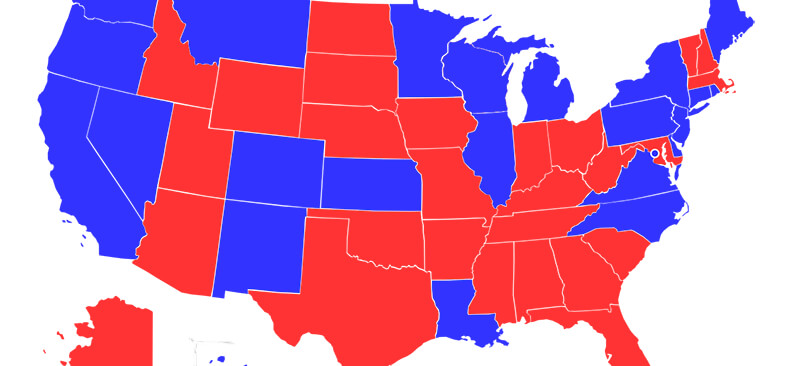[INSIGHTS] Do Republicans Avoid Public Participation?

Over the past few years, MetroQuest has grown to become the most widely used digital public engagement platform in North America. But its use is not as evenly distributed as you’d imagine.
As our clients and projects grew over the past few years we suspected that clustering was happening, but with our heads down it was difficult to see the forest for the trees. It wasn’t until we plotted the number of projects in each state on a map that we were able to visualize this effect. It didn’t take long to realize that we’d seen that pattern before. It was the map of red states and blue states! We discovered that MetroQuest is used 3 times more frequently in blue states than red states. This is especially puzzling since the results have been excellent when we have the opportunity to work in Republican-dominated areas and we’ve found the leaders to be highly supportive.

There were just a few anomalies that didn’t fit the pattern such as Texas. When we drilled a little further into the regional data we discovered that the frequency of projects in blue regions like Austin was skewing the results for the state.
What’s going on? The majority of clients use MetroQuest specifically to engage more people from a broader demographic than typically participate in the planning process. Does this mean that, on average, Republicans are less interested in promoting greater participation in the planning process than their Democrat counterparts? This explanation doesn’t fit with our project experience. So is there another explanation? Could it be explained by population density and urbanization alone?
So now it’s over to you. What do you suppose is behind this pattern? What have you seen in your practice?
Republicans, whether justified or not, may have an interest in having public policy decisions controlled by a smaller group, giving them more power.
Maybe so but you’d think that would apply to anyone in power.
My first thought (before I read your comment at the end of the article) was that population density definitely plays a part in the difference. There are other explanations such as – they could be using a different vendor who is local to their area to do their public involvement; they may be doing their public involvement in-house; funding in less populated areas may be an issue, since urban areas tend to receive more funding and have more projects. If you compare a population density map of Texas to your public involvement projects map, your projects pretty much correlate with the higher density population areas.
It’s true that we do more projects in urbanized areas and it certainly makes sense that the funding is more heavily allocated to those regions. To be clear, the map of Texas was the Democrat and Republican voting pattern of the last election and not our project density map. I should have labeled the image.
Dave, instead of “Republicans” I would use the term “conservatives” when describing this group who staunchly believe in individual freedom, small government, and property rights. In general, they see the public planning process as an example of central planning where a government entity (along with a group of special interests) imposes collective values onto individual land owners, through land use planning process and zoning codes, instead of letting the free market and the concept of “highest and best use” play out on a case-by-case basis. That is why you’ll see, in many strongly conservative parts of the USA like Texas, no zoning codes and more of a laissez-faire approach to land use. Most planners by definition believe in a top-down approach where the collective needs of the community are more important than those of an individual property owner, whereas conservatives would rather do as they wish with their own property.
Very thoughtful reply Lex. Thanks for taking the time to lay that out.
I think there’s a perception that the less information the government has about a community, the less money the government will spend on that community — often a goal for fiscal conservatives. This has been reiterated by multiple attempts to defund the Census, ACS, AHS, and other survey instruments. http://www.nytimes.com/2012/05/20/sunday-review/the-debate-over-the-american-community-survey.html
In practice, I believe that the just because decisionmakers are lacking information doesn’t mean they won’t make spending decisions; it just means they might not make the best decisions.
I think it is “conservatives” for a reason and as such there might be preference for good old way of meeting in person, town halls meetings, etc. rather than the virtual aspect of it.
Interesting, thanks RH
Is it really necessary to politicize this? Is there anyone in the planning field that can refrain from bashing “Republicans?”
Agreed Mary. I certainly didn’t want to invite bashing. I’ve really enjoyed some of the more constructive contributions here and can do without the negative ones.
My past experience in Canada and overseas in over 40 countries was that the introduction of Public Participation was often met with indifference and even hostility. The Alberta Government was a trailblazers in the `70s on Environmental Assessmt hearings, as industry chafed at the requirement. Quebec was always strong in this regard. B.C. was officially unenthusiastic in my opinion, opting for land use planning models. African and Asian staes were slow, often because of tradiitional consultative methods (the sheik and is people, the Panchayat system in Nepal, and Communist methods elsewhere).
The National Environmental Policu Act (1971) brought in by the Nixon government was ten years in the making. It brought forward public consultation as a requirement on project reviews in a process that was copied by over 80 countries world wide
including Canada. However the public information and consultation activity was an unpopular activity for many governments, and it still is.
Keep up the good work, Dave.
Patrick Duffy, Vancouver
Wow Patrick! Your insight and decades of experience is greatly appreciated. Thanks for weighing in.